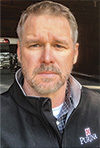Every dairy producer wonders how much they dare overcrowd the freestall barn. When asked that question, I usually respond that they can go 15 percent over for a two-row pen and 5 percent over for a three-row pen. However, I do realize that’s likely the wrong answer for almost everyone.
Some farms start to lose milk as soon as they go over 100 percent capacity. They’re actually producing the same total pounds of milk per day at 120 percent capacity as they did at 100 percent capacity. On the other end of the spectrum, I’ll find herds that seem to be able to break the rules and overcrowd three-row pens by 35 to 40 percent and still have a bulk tank average of 90 to 100 pounds of milk.
There’s not as much mystery in this as I once thought. There are several things the successful crowders are doing that others are not.
1. Never overcrowd the pre- and post-fresh pens. They attempt to never be over one cow per freestall. For all these cows to eat at one time, 80 percent of stall space in a three-row pen is ideal, but unfortunately, it doesn’t always happen that way.
2. Group first-calf heifers separately from mature cows. Research from the Miner Institute shows dry matter intake for heifers dropped off severely in comingled pens once bunk space got below 20 inches per head.
3. Push up feed frequently. Because not all cows can eat at once, it’ll be especially important for less dominant cows to have feed available when they actually do get a chance to go to the feed line. A good goal is to push up feed every two hours. Timing is important and the more frequent, the better. I have seen successful crowders push up as many as 16 times per day.
4. Provide very comfortable stalls. Stall time is precious, so if a cow is using a stall, she needs to be lying down in it. If she’s standing in the stall, she might as well be standing in the alley and giving someone else access to the stall.
5. Excel in heat abatement. Having more cows per square foot results in a much higher heat load. This makes adequate sprinklers and air movement especially important to avoid severe summertime losses.
6. Maintain at least 2 inches of water space per cow (3 to 4 inches is ideal). This takes some extra effort and management. Overcrowded three-row pens easily get down to 1 to 1.5 inches of water space.
7. Focus on foot health. Crowding puts more stress on feet and legs, which leaves no room for error when it comes to trimming and footbaths. Lame cows do not tolerate being overcrowded, and research has shown that they have severe losses.
8. Feed rations that are not sortable. This becomes a challenge because not all cows can eat at once, yet we want all cows to consume the same ration. Closely monitoring the particle length and moisture of the total mixed ration are important factors to prevent sorting.
9. Put extra attention into keeping cows clean. More cows means there will be more manure. This will require scraping three times per day to keep the alleys cleaner and hygiene scores acceptable. This often makes it difficult for herds milking 2X to maintain a clean environment. Unfortunately, mastitis can quickly rob any milk production gained from overcrowding if hygiene is inadequate.
Most people involved with cows on the farm would prefer to operate at a 100 percent stocking rate so every cow has her own stall and plenty of eating space. But dairy economics often make it difficult for that to be financially feasible. On paper, it always looks like overcrowding will increase milk revenue and dilute out fixed costs. However, we know that the real challenge is finding the tipping point where the laws of diminishing returns start and additional cows no longer add to profitability.
It’s tempting to look at what a fellow dairy producer is doing and think that should apply to your own operation. Just because another operation is overcrowding its three-row pens by 30 percent and getting 90 pounds of milk doesn’t necessarily mean that will apply to your operation. Also, keep in mind it is entirely possible the same farm might average 100 pounds if they were less crowded. ![]()

-
Ron Munneke
- Dairy Nutritionist
- Purina Animal Nutrition
- Email Ron Munneke
PHOTO: With careful management, some dairies are able to maintain high levels of production despite overcrowding. Photo by Peggy Coffeen.





